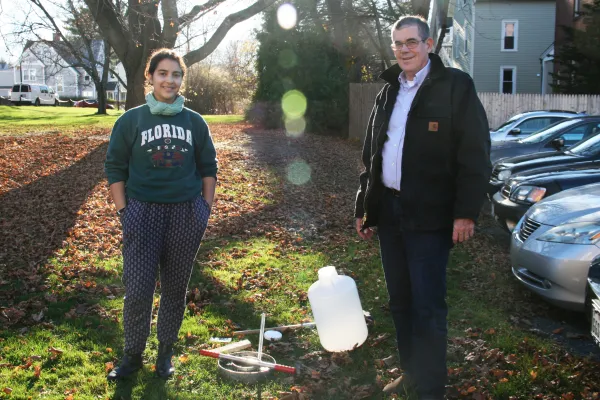Real-World Solutions: “Green” Pavement Project Underway Near the Quad
Sustainability

Published November 16, 2015
In a quiet corner of campus, an experiment is underway that promises to help demonstrate new ways to manage stormwater in the context of climate change.
A 12-car student parking lot on Mandelle Road, adjacent to the Quad, is being transformed into a laboratory to test the effectiveness of permeable pavement—the kind that allows stormwater to move through and be absorbed into the ground.
Permeable surfaces not only help reduce stormwater runoff, but may also trap and filter pollutants that can harm water quality, says geosciences professor Robert Newton, director of Smith’s Center for the Environment, Ecological Design and Sustainability (CEEDS)—which is overseeing the pavement project.
“There’s an environmental gain from reducing runoff that can be tracked from the first rainfall after the pavement is put in,” Newton said.
How big a gain? That’s what the experiment aims to find out.
Scientific instruments are being installed under the 60- by 50-foot lot so students can measure runoff and infiltration and collect samples for water quality analysis. Early next semester, half of the lot will be paved using permeable asphalt, and the other half will be paved using traditional asphalt to allow comparisons.
Andrea Schmid ’17—an environmental science and policy (ES&P) major who has been involved in the pavement project since last spring—says it started with a class assignment examining the city of Northampton’s efforts to encourage better management of stormwater. This year, the city began billing property owners based on the amount of impermeable surface they own.
Schmid and fellow environmental science and policy majors did a study of the impact that increased use of permeable pavement could have on stormwater management on campus.
“When we included the educational aspects of using the [Mandelle] parking lot as a lab, the benefits were even greater,” said Schmid, who helped design the pavement experiment over the summer and is now doing an independent study, installing equipment and testing the soil on the lot.
As the project evolved from class assignment to a part of operations at Smith, Schmid said she “started to understand how sustainability projects on campus are related to institutional change.”
Schmid, who has been a campus sustainability intern this semester, said, “I think about infrastructure in a totally different way now. This is a good example of how these projects can work in the real world.
Camille Washington-Ottombre, assistant professor of environmental science and policy, says the permeable pavement lab is part of a new emphasis at Smith on responding to the effects of climate change.
“Besides reducing our energy use and greenhouse gases, climate change is about our ability to respond to more intense rain and snow events,” said Washington-Ottombre, who taught the ES&P research methods class where the pavement project began.
“Such resilience is a new way of thinking about sustainability on campus,” Washington-Ottombre said. “Smith has been a leader on climate change mitigation, and now with this project, it can lead on resilience.”
Dano Weisbord, Smith’s director of campus sustainability, says the pavement project is unique in being a collaborative effort among students, faculty and staff.
“Andrea had a classroom project that we’re putting to the test on campus,” Weisbord said. “Students will be able to use this parking lot as a lab to look at stormwater dynamics, while our facilities department will be able to judge how this approach will fare under snow, ice and freeze/thaw conditions.”
Peter Gagnon, capital construction director for facilities management, said his department is enthusiastic about what the parking lot experiment may mean for expanding the use of permeable pavement on campus.
“We’re excited about a greener way of doing things,” he said.
Andrea Schmid '17 and Prof. Bob Newton, director of CEEDS, set up instrumentation for measuring stormwater runoff from the Mandelle Road parking lot, where a new permeable pavement surface will be installed next semester. Photo by Isabella Casini '17